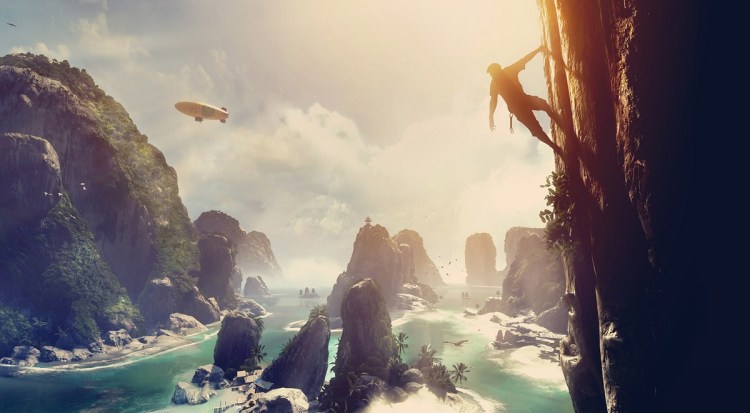Virtual reality is a great substitute for exploring new things that you would never dare in real life. That’s the premise behind The Climb, the first virtual reality game from hardcore game publisher Crytek.
The game is part of a tsunami of content being created for VR, which is expected to become a $30 billion market by 2020, according to tech advisor Digi-Capital. The title could be one of the flagship games for the Oculus Rift, the VR platform that Facebook’s Oculus VR division is expected to launch early next year. The difference between this VR title and many others is that this one is coming from a hardcore game studio that has decades of experience making blockbuster games.
I got a hands-on preview of The Climb during an interview with Crytek game designers David Bowman and Rock Erjavec, as well as Jason Rubin, the head of worldwide studios at Oculus VR. It really felt like I was scaling a cliff on a huge rock formation at a tropical location in Southeast Asia. The Climb is exclusively releasing on the Oculus Rift.
The Climb runs on a PC with a decent graphics card. As I donned the Oculus Rift headset, I was standing in front of a cliff, with a first-person view of the rocky surface in front of me. Bowman placed an Xbox One controller in my hand. I squeezed the right trigger and a virtual right hand reached out and grabbed a handhold on the wall. I pointed a cursor at another handhold and squeezed the left trigger. My virtual left hand reached out and grabbed the wall.
When I let go of the right trigger, I freed up a hand to grab higher up the cliff. I looked around and could see all around me, up and down, left or right. I was starting to feel a bit precarious as I climbed higher. When I reached out and let go too early, I fell off the wall and plunged downward. Fortunately, there was a save point. I didn’t have to start climbing the wall all over again. There were a few times when I had to jump upward and pull the trigger fast to grab a handhold.
Bowman said the designers have learned a lot in making The Climb. They made sure that when you fall, you start to go down. But you don’t plunge all the way to the bottom and bounce off the rocks. That would be too jarring to experience in VR, and it would make a lot of virtual climbers sick.
“We learned that makes people really uncomfortable,” Bowman said. “We also had a lot of lessons about camera control. We make sure that we adjust the camera as you pull your body around a corner. We smooth it out so that you don’t notice it.”
The team making the title is in Frankfurt, Germany, where Crytek is based. Crytek owns the intellectual property. Rubin said that Oculus’ standard policy for games that it has funded with outside developers is to give the rights to the intellectual property and its sequels to the developer that creates a VR title.
Crytek previously created two dinosaur VR experiences, Back to Dinosaur Island and its sequel. Those were demos aimed at showing what the CryEngine could do. They included a climbing demonstration that the team decided could be a lot of fun in a real game.
“This is the first full VR game that we have for the launch,” Bowman said. “This evolved out of our technology improvements for VR in our game engine.”
The Climb runs at 90 frames a second, and the quality of the art really holds up, even at a resolution of 1080 by 1200 in each eye, Rubin said. The demo I saw was running on a PC with a single graphics card with an Nvidia GeForce GTX 980 graphics chip.
The Climb will have competition. Iceland’s Sólfar Studios announced that it is making Everest VR, a VR travel-adventure app that makes you feel like you’re part of an expedition climbing Mount Everest. I tried that app out with an Nvidia-equipped PC and the HTC Vive virtual reality headset. Both games are very realistic. While Sólfar Studios seemed focused on a photorealistic approach aimed at replicating the look and feel of Everest, The Climb is aimed at re-creating the actual experience of climbing in a game-like animated world.
In both demos, I felt that sense of “presence,” or the feeling that I really was there. If I looked down, I felt a slight sense of vertigo as it seemed like I was perched on a cliff above a dangerous rock formation.
Crytek’s game will have easy, medium, and hard surfaces in multiple locations. You’ll be timed on how long it take you to scale the cliff. It took me about 20 minutes. It takes the game testers about 2.5 minutes to do it.
You can try again and try to beat your time. In the future, Crytek may adjust the game so that it uses the Oculus Touch controllers, which would allow you to move your hands independently.
“The whole point is to make it visceral, so that you really feel immersed in a place,” Bowman said.
VentureBeat's mission is to be a digital town square for technical decision-makers to gain knowledge about transformative enterprise technology and transact. Learn More





